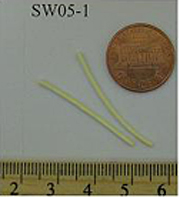- Number 317 |
- August 2, 2010
Carbon capture research focuses on lowering cost

Hollow membrane fibers made
out of an ionic liquid.
Researchers at DOE's National Energy Technology Laboratory are working on ways to reduce significantly the emission of CO2 by developing cost-effective technologies to capture the gas before it has a chance to enter the atmosphere. One of the more novel approaches under investigation is the use of ionic liquids. An ionic liquid is an organic salt that, in many ways, is similar to common inorganic table salt (NaCl). The reason ionic solutions remain liquid (rather than solid) at room temperature lies in the shape of their ions. The sodium (Na) and chlorine (Cl) that make up table salt are small, spherical ions. Their compact shape allows them to stack very efficiently into cubic crystal structures, so that they melt only at high temperatures. Unlike table salt, ionic liquids contain larger organic ions with much more complicated shapes that cannot stack as efficiently. Consequently, they become liquid at much lower temperatures.
The simplest way to capture CO2 with ionic liquids is by means of liquid scrubbing, whereby flue gas bubbles through large tanks of the ionic liquid, allowing the CO2 to leave the flue gas and dissolve in the liquid. When the liquid becomes saturated with CO2, it is pumped into another tank where it is heated, causing the CO2 gas to escape from the liquid for easy capture. The gas can then be compressed and pumped deep underground for long-term storage.
Another way to capture CO2 using ionic liquids is to convert the liquid into a membrane (ionic liquids make excellent membranes when they are placed in the pores of solid films). These ionic membranes act like selective gates that allow CO2 to pass through while keeping out all other gases. NETL researchers have discovered that they can convert these thin membrane films into thin hollow fibers, shown in the figures below. When the flue gas is passed over the outside of these tube-like fibers, CO2 gas passes into the center for ducting away to compression and permanent sequestration.
To learn about other NETL research projects related to this problem area, go to: http://www.netl.doe.gov/technologies/carbon_seq/index.html; http://www.netl.doe.gov/newsroom/netlog/july2010/netlog_Jul10.html#4, and; http://www.netl.doe.gov/newsroom/netlog/july2010/netlog_Jul10.html#10[Linda Morton, 304.285.4543,
Linda.morton@netl.doe.gov]
